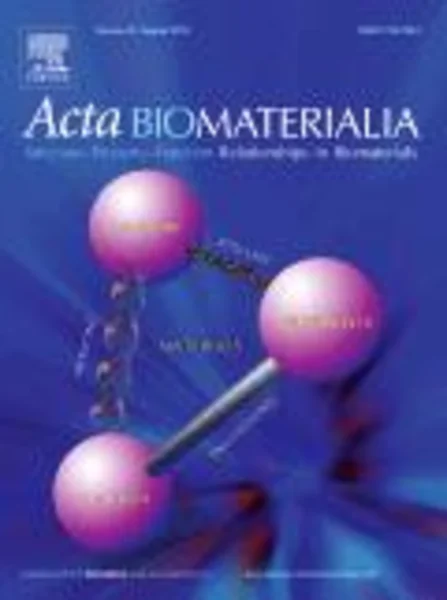-
microbubbles as biocompatible porogens for hydrogel scaffolds
جزئیات بیشتر مقاله- تاریخ ارائه: 1392/01/01
- تاریخ انتشار در تی پی بین: 1392/01/01
- تعداد بازدید: 823
- تعداد پرسش و پاسخ ها: 0
- شماره تماس دبیرخانه رویداد: -
in this study, we explored the application of lipid-shelled, gas-filled microbubbles as a method for creating on-demand microporous hydrogels for cartilage tissue engineering. the technique allowed for homogenous distribution of cells and micropores within the scaffold, increasing the absorption coefficient of large solutes (70 kda dextran) over controls in a concentration-dependent manner. the stability of the gas phase of the microbubbles depended on several factors, including the initial size distribution of the microbubble suspension, as well as the temperature and pressure during culture. application of pressure cycles provided controlled release of the gas phase to generate fluid-filled micropores with remnant lipid. the resulting microporous agarose scaffolds were biocompatible, leading to a twofold increase in engineered cartilage properties (ey = 492 ± 42 kpa for the bubble group vs. 249 ± 49 kpa for the bubble-free control group) over a 42-day culture period. our results suggest that microbubbles offer a simple and robust method of modulating mass transfer in cell-seeded hydrogels through mild pressurization, and the methodology may be expanded in the future to include focused ultrasound for improved spatio-temporal control.
مقالات جدیدترین رویدادها
-
استفاده از تحلیل اهمیت-عملکرد در ارائه الگوی مدیریت خلاقیت سازمانی و ارائه راهکار جهت بهبود
-
بررسی تاثیر ارزش وجوه نقد مازاد بر ساختار سرمایه شرکت های پذیرفته شده در بورس اوراق بهادار تهران
-
بررسی تأثیر سطح افشای ریسک بر قرارداد بدهی شرکت های پذیرفته شده در بورس اوراق بهادار تهران
-
بررسی تأثیر رتبه بندی اعتباری مبتنی بر مدل امتیاز بازار نوظهور بر نقد شوندگی سهام با تأکید بر خصوصی سازی شرکت ها
-
تأثیر آمیخته بازاریابی پوشاک ایرانی بر تصویر ذهنی مشتری پوشاک ایرانی (هاکوپیان)
-
بررسی اثر ارتز کاهنده تون در کودکان دایپلژی اسپاستیک 8-2 ساله
-
تاثیر یک جلسه تمرین مقاومتی دایره ای بر سطح پلاسمای میوژنین و میوستاتین زنان والیبالیست جوان
-
تجلی آیات قرآن در دیوان کلیات شمس تبریزی
-
تاثیر مصرف مکمل کاسنی بر میزان سرعت عکس العمل بازیکنان پسر تنیس روی میز (12-8) سال شهرستان گراش
-
رابطه هوش معنوی، فراشناخت و باورهای خوداثربخشی با پیشرفت تحصیلی دانشجویان
مقالات جدیدترین ژورنال ها
-
مدیریت و بررسی افسردگی دانش آموزان دختر مقطع متوسطه دوم در دروان کرونا در شهرستان دزفول
-
مدیریت و بررسی خرد سیاسی در اندیشه ی فردوسی در ادب ایران
-
واکاوی و مدیریت توصیفی قلمدان(جاکلیدی)ضریح در موزه آستان قدس رضوی
-
بررسی تاثیر خلاقیت، دانش و انگیزه کارکنان بر پیشنهادات نوآورانه کارکنان ( مورد مطالعه: هتل های 3 و 4 ستاره استان کرمان)
-
بررسی تاثیر کیفیت سیستم های اطلاعاتی بر تصمیم گیری موفق در شرکتهای تولیدی استان اصفهان (مورد مطالعه: مدیران شرکتهای تولیدی استان اصفهان)
-
بررسی رابطه دلبستگی به والدین با سلامت روانی و گرایش به رفتارهای پرخطر در نوجوانان
-
نقش کارآفرینی سبز بر عملکرد زیست محیطی «براساس مدل خودسازماندهی»
-
بررسی آثار اقامتگاه در حقوق بین الملل خصوصی
-
عناصر فرهنگ ساز در مرصاد العباد
-
experimental study of using organic waste ash (owa) instead of cement in concrete




سوال خود را در مورد این مقاله مطرح نمایید :